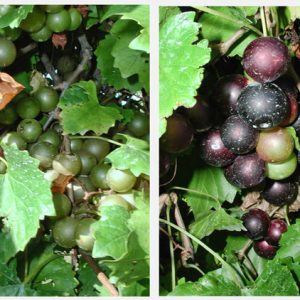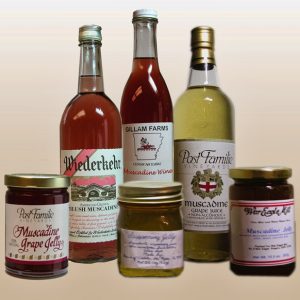calsfoundation@cals.org
Muscadine
aka: Vitus rotundifolia
Muscadines (Vitis rotundifolia) are grapes native to Arkansas and other parts of the southeastern United States. The grapes have thick skins, large seeds, and a unique, soft, musky-flavored pulp. Cultivars can vary in color from almost white to nearly black. Common names for dark-fruited muscadines include bullace, bull grape, and Southern Fox. The term “scuppernong” is often used to refer to all bronze-fruited varieties, but it is actually the name of a specific muscadine cultivar.
The muscadine cultivars most commonly grown in Arkansas for commercial juice and wine production include Carlos, a bronze cultivar that produces light-colored products and white wine, and Noble, a dark cultivar that makes deep-red products. Consumers who are accustomed to the unique qualities of muscadines, or who have developed a taste for them, describe these grapes as a welcome alternative to the better-known “California types” of grapes.
Muscadines grow wild in Arkansas, except not generally in the northern counties; however, they were not grown commercially in the state until 1972. The total acreage of muscadine production in Arkansas is not known, but there are commercial plantings for fresh market sales in several counties, most notably White County. In addition to use as fresh fruit, muscadines can be used for processing. Muscadine wine is the major processed product; however, there have been efforts in recent years to establish markets for muscadine jam, jelly, and juice. Two of the foremost commercial processors of muscadine products, Post Familie Vineyards and Winery and Wiederkehr Wine Cellars, are located in the Altus (Franklin County) area. Other wineries, including Mount Bethel and Cowie Wine Cellars, also produce muscadine wines.
Approximately forty percent of the muscadine grape is skin and seed, which become waste products when muscadines are processed. Although efforts to breed seedless muscadines and fruit with softer skins is ongoing, researchers have found that muscadine seeds and skins contain a number of nutraceuticals and may benefit human health. Research is currently under way to identify better the nutraceuticals in muscadine waste products and determine how they can be used.
For additional information:
Basiouny, Fouad M., and David G. Himelrick, eds. Muscadine Grapes. Alexandria, VA: ASHA Press, 2001.
Carson, Janet B. “Mad about Muscadines.” Arkansas Democrat-Gazette, September 17, 2022, pp. 1E, 6E. Online at https://www.arkansasonline.com/news/2022/sep/17/mad-about-muscadines/ (accessed December 14, 2023).
Moore, J. N. “Performance of Muscadine Grape Cultivars in Arkansas.” Arkansas Agricultural Experiment Station Report Series 200. Fayetteville: Arkansas Agricultural Experiment Station, 1972.
Morris, Justin R., and Pamela L. Brady. “The Muscadine Experience: Adding Value to Enhance Profits.” Arkansas Agricultural Experiment Station Research Report 982. Fayetteville: Arkansas Agricultural Experiment Station, 2007. Online at https://scholarworks.uark.edu/cgi/viewcontent.cgi?article=1016&context=aaesrb (accessed December 14, 2023).
Striegler, Keith. “Muscadine Grape Production in the Home Garden.” University of Arkansas Cooperative Extension Service. https://www.uaex.uada.edu/publications/PDF/FSA-6108.pdf (accessed December 14, 2023).
Striegler, R. K., P.M. Carter, J. R. Morris, J. R. Clark, R. T. Threlfall, and L. R. Howard. “Yield, Quality and Nutraceutical Potential of Selected Muscadine Cultivars Grown in Southwestern Arkansas.” HortTechnology 15.2 (2005): 276–284.
Pamela L. Brady
University of Arkansas, Fayetteville
 Muscadine Grapes
Muscadine Grapes  Muscadine Products
Muscadine Products 




Just wanted to point out that muscadines do grow wild in northern counties. We have then growing wild on our land in northern Greene County.